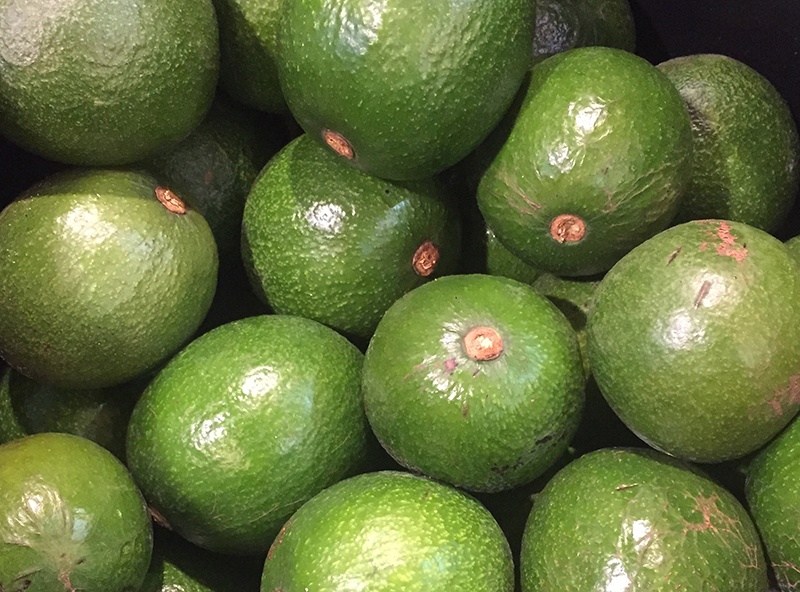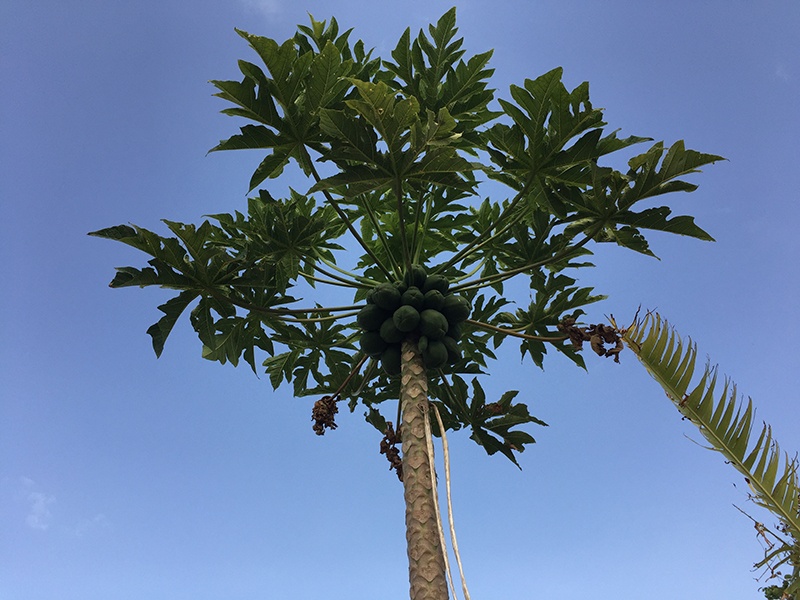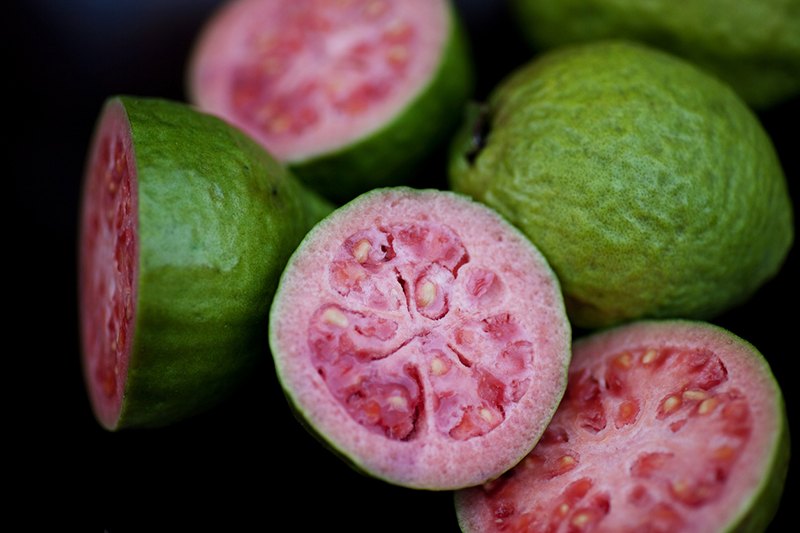Seven Low Maintenance Tropical Favorites You Can Grow at Home
Growing up in the islands leaves you with very distinct sensory memories. Maybe it’s the way the afternoon rain hits your skin when the trade winds are blowing. The wind dries you within a few minutes and the quick cooling effect is so welcome. It’s just enough to cool you off. Perhaps it’s the way the waves massage and nourish your skin as you sit at the water’s edge. For some, it’s the taste or smell of the islands.
For many, the taste of the juicy, sweet fruits that grow so abundantly here is the taste of home. Some of the flavors of Hawaii simply can’t be replicated anywhere else in the world. It’s true. Growing up enjoying Hawaii’s sweet, tropical fruit can dull your senses for all the other fruit experienced on the mainland. Apples and oranges simply can’t compare to pineapple and mango. For many locals, they’re the taste of our childhood!
Some of our favorite local fruits grow with little effort, right in our own tropical backyards. This is truly a benefit and one reason why locals always say, “lucky we live Hawaii.” You really can have your own farmer’s market in your backyard and it doesn’t take much effort to get one started. Here are our seven tropical fruits that pretty much tend themselves.
Mango
Mango trees are found throughout the islands. Hiking through rainforest valleys, you’ll often be overwhelmed with the sweet aroma of mangos being devoured by the birds. But most locals don’t go farther than their own backyard to pick both green and ripe mangoes.
The islands have many varieties of mango. The most abundant and common types are the Hayden and Pirie. Mango season runs from May through September in Hawaii, peaking in July and sometimes running as late as October. Most fruit is harvested during the summer month of July, when the Hawaii summer is really starting to heat up. Chilled mango at the height of summer is the perfect afternoon treat to help you cool off.
A mature mango tree in your yard can grow tall enough to provide shade on a sunny afternoon, and can even grow to 100 feet in height, providing shade for your home, too. Large, mature trees can yield hundreds of mangoes through the summer season. With a tree this size, you’ll have so many mangoes that you’ll be happy to share them with family and friends. Don’t worry, you’ll still have plenty left over to pickle some green ones, make a few jars of mango chutney, and cube several freezer bags worth for a quick and easy smoothies.
Avocado
Avocados don’t originate in Hawaii, of course. In fact, most of our favorite tropical fruits weren’t endemic to Hawaii, but like many transplants, they thrive here! Our year-round sunshine, fertile soil and tropical rains have made many fruits a better version of their former selves. The avocado is one such fruit!

Backyard local avocado harvest
Hawaii residents and farmers now grow more than 200 varieties of avocado. Some of our favorites are the Malama and Kahalu‘u varieties. The Malama gives a lot of fruit that is ripe in early fall. Its skin is purple and the fruit is nutty with a very rich, creamy flavor. The Kahalu’u variety is another fall bearing tree, but can alternate years. If your tree doesn’t give fruit this year, be patient because next year’s harvest will be worth the wait. Many locals consider Kahalu’u avocados as the best-flavored variety the islands have to offer.
Like mango trees, avocado trees can become quite large and need at least 25 feet of space between them. Remember to avoid picking the fruit too early. You should wait until the skin of the fruit goes from shiny gloss to a matte finish before harvesting your avocado tree.
Lychee
This delicacy originates in Asia, but has made it’s home in many local backyards. Eating lychee is an adventure. Break the thick prickly barrier near the top and then peel the red skin off, revealing tender, translucent white flesh of the fruit itself. Fresh or chilled by itself, or in a tropical fruit salad, are the best ways to enjoy this delicious fruit. We recommend that you freeze any extra fruit your tree produces, in order to preserve the sweetness. Defrost a few in the fridge to enjoy after the season comes to a close. For something a little extra special, use lychee in your favorite tropical cocktail.
Lychee trees can grow to 40 feet in height, though if you have one in your yard, we suggest giving it a serious pruning in alternating years to ensure a good harvest. The fruit starts to form in May as little green balls on the plant. As the summer progresses, the green bulbs develop a red, bumpy skin that is even a bit prickly to touch. Harvest takes place at the end of June and July for most locations in Hawaii, with some trees still producing fruit through August.

Apple bananas, lychee and pineapple
Lychee trees do better in the wetter communities on the islands where rain is abundant. That isn’t to say you can’t cultivate the sweet fruit in some of the drier areas, but you’ll need to provide your lychee tree with a healthy daily dose of water.
Apple Bananas
Don’t expect Chiquita bananas here on the islands, except in the supermarkets. In fact, after enjoying fresh apple bananas, you may never look at the Chiquita the same way again. Apple bananas, along with about 70 other local varieties, love the damp wet weather. A common misconception: the apple banana doesn’t look or taste like an apple. It’s about half the length of your traditional supermarket banana, yet it has a delightfully tart sweetness.
With enough watering, you can produce a banana tree just about anywhere on the islands and the good news is, they produce fruit year round. If you’ve ever wondered why Hawaiian banana bread is simply the best, this plentiful fruit is your answer. Apple bananas that are just lightly dried make an absolutely delicious, portable, and chewy treat that’s perfect to bring on a hike or to the beach, to refuel after your island adventures.
Papaya
Papaya trees grow almost as fast as weeds. Almost! The point is you can have a fruit-bearing tree very quickly. In fact, Grandma said that if you slice the papaya in half and take the first five seeds closest to the stub, you’ll have the female seeds to plant and those trees will bear you fruit. Grandma has a pretty good green thumb, so we’re going to trust her.

Papaya tree in a Kailua backyard
Papaya trees don’t take much space and you can have four or five tree stalks along the perimeter of your yard. Packed into that 8-inch oblong yellow-orange fruit is a smooth, rich sweetness unlike any other fruit you’ve tasted. Hawaiian papayas are not watered down, like their larger mainland or Mexican counterparts. Their flavor packs a delicious, creamy punch! Papaya trees can start producing fruit when they are just four feet tall, but they will grow to more than 20 feet tall in fertile areas. Get your ladder out when the fruit is ripe, before the birds (or worse) start coming round to steal them from you!
Lilikoi
The smooth skin on this fruit is what tells you you’re not holding a tennis ball, though it’s almost the same color. Lilikoi is commonly referred to as passionfruit and it invokes passionate fans indeed. Here in Hawaii, we make lilikoi everything — from jam and jelly to lilikoi pancake syrup. Every grocery store stocks favorite blends of juice using passionfruit.
Lilikoi plants are vines that usually crawl along chain link or wooden fences surrounding the backyard. While lilikoi provides fruit all year long, it peaks during the summer with green bulbs turning into bright yellow balls on the vine. As the fruit ripens, the smooth skin dimples.
Don’t get confused when eating a fresh lilikoi. Slice it in half, using its shell as a cup. Inside you’ll see the flesh—bright orange with black seeds—a lot of black seeds. Don’t worry about getting rid of them. Slurp it all up! It glides down effortlessly. If you’ve picked your fruit too soon, you’ll know by the uncontrollable pucker of your lips. Add a teaspoon of sugar so as not to waste this golden fruit.

Local fruit basket & backyard harvest
Guava
Hawaiian guavas are not just tasty, but they add a pleasantly sweet aroma to your garden. There are several varieties, though most common are the Hawaiian yellow guava which have a hardy pink flesh. Just like papaya, be sure to grab your guavas before the birds do. They love the sweet inner flesh. Just like lilikoi, don’t try to eat around or spit out the seeds. The whole guava is edible, though even ripe guavas may have a bitter skin. Enjoy them right off the tree or use them in a favorite fruit salad
The prime guava season is October through January, but you’ll probably enjoy fruit throughout the year if your tree gets abundant water. The trees don’t get too large and fit nicely in the corner of the yard. With an abundant harvest, make a few jars of fresh guava jam for toast or syrup for your pancakes.

Fresh and juicy guava
Of course, these are just a sampling of the amazing fruit you might be able to grow in your backyard or find on a hike, if you know what to look for. Dragon fruit, mountain apples, star fruit and Surinam cherries are abundant in the islands. You’ll also see healthy trees filled with tangerines and grapefruit, if you keep your eyes open.
If your backyard doesn’t have mature trees or vines to produce an abundance of fruit, get to know your neighbors. Many are happy to share as they don’t want the fruit to go bad. The aloha spirit permeates in our love of fruit and desire to share.

Leave your opinion here. Please be nice. Your Email address will be kept private, this form is secure and we never spam you.